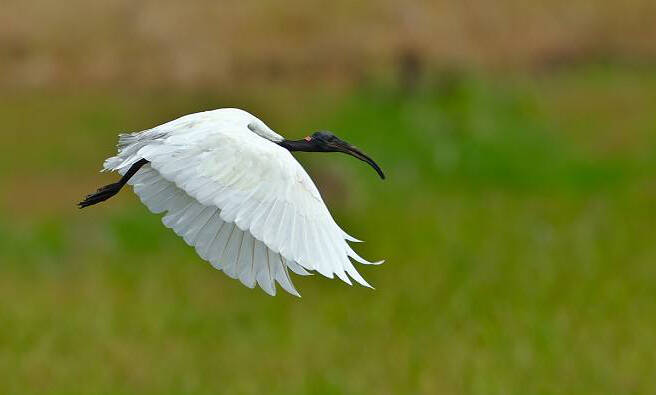Threskiornis melanocephalus
IUCN
LCBasic Information
Scientific classification
- name:Threskiornis melanocephalus
- Scientific Name:Threskiornis melanocephalus,Black-headed Ibis,White Ibis
- Outline:Wading birds
- Family:Ciconiiformes Ibisidae Ibis
Vital signs
- length:65-75cm
- Weight:1.5kg
- lifetime:About 10-20 years
Feature
It is one of the world's endangered species.
Distribution and Habitat
Distributed in Bangladesh, Cambodia, Mainland China, Hong Kong, India, Indonesia, Malaysia, Myanmar, Nepal, Pakistan, Philippines, Russian Federation, Sri Lanka, Thailand, Vietnam.
Migrant bird: Japan, Republic of Korea, Lao People's Democratic Republic, Mongolia.
In China, it is distributed in Tianjin, Hebei, Inner Mongolia, Liaoning, Jilin, Heilongjiang, Shanghai, Jiangsu, Zhejiang, Taiwan, Shandong, Henan, Guangdong, Hong Kong, Hainan, Sichuan, Yunnan and other places. Among them, it breeds in Heilongjiang, Jilin and Liaoning, some winter in Guangdong and Fujian, and are seen in other areas during migration, and occasionally in Yunnan.
It likes swamps with many reeds and flooded grasslands. It often forms small groups, constantly moving around to find food or flying in groups. It nests in mixed groups with storks and other water birds.
Appearance
In summer, the whole body's feathers are white, but the head and upper part of the neck are exposed, black, sometimes embellished with blue, which is an obvious difference from other species. There are extended gray feathers on the back and the lower part of the front neck. There are exposed dark red skin spots on the underside of the wings and extend along the edges of the wings to the lower sides. The wingtips exposed during flight are black. The winter feathers are generally similar to the summer feathers, but there are no extended gray feathers on the back and front neck, and the exposed skin spots under the wings turn orange-red.
The black mouth is slender and curved downward. The iris is red or reddish brown. The legs are shorter and also black.
Size measurement: body length 650-750mm; mouth peak 135-190mm; wings 343-370mm; tail 120-145mm; tarsometatarsus 95-116mm. (Note: ♂Male; ♀Female)
Details
Black-headed Ibis is a large wading bird.

Black-headed Ibis usually moves in small groups, and sometimes they are seen alone by the water or on the grass. It is active during the day, and is silent when active. Usually, its calls are almost unheard, and it walks very lightly and calmly. When flying, its head and neck are stretched forward, its feet are stretched backward, and its wings flap slowly and powerfully. It flies slowly and calmly, but faster than other herons and storks, and can occasionally glide. It mainly feeds on animal food such as fish, frogs, tadpoles, insects, insect larvae, worms, crustaceans, mollusks, and small reptiles, and sometimes also eats plant food. It forages in shallow water near the water, and also forages on land and coasts. When foraging, it often walks slowly along the water's edge, and from time to time it inserts its mouth into the water to explore or peck at the surface of the food. It also often inserts its long and curved mouth deeply into the mud or water in shallow water near the water or on muddy ground to detect food, and sometimes even immerses its entire head and neck in the water.
The breeding season of the black-headed white ibis is from May to August every year, during which time it often makes louder calls. It builds nests alone, in groups, or in mixed groups with other birds such as herons and storks. Most nests are built on large trees or bushes near water, and sometimes on large trees near human residences. They are mainly made of dead branches, with only a small amount of twigs, dead leaves and feathers inside, and sometimes there is no padding at all. The nest is shared by male and female birds. Usually the male bird goes out to find and transport nesting materials, while the female bird stays on the nest to guard the nesting materials and build the nest.
The nest is cup-shaped or shallow bowl-shaped, with an outer diameter of about 35 cm, an inner diameter of about 20 cm, a nest height of about 20 cm, and a nest depth of about 10 cm. Each nest lays 2-4 eggs, usually 3. The eggs are oblong, oval or pear-shaped, white or light blue, with a few brown spots, the blunt end of which is denser. The incubation period is 23-25 days. The male and female birds take turns to incubate the eggs. The parent bird that is not responsible for incubating the eggs goes out to find food. When it comes back, it always repairs the nest with reeds in its mouth. The parents are very intimate with each other during the entire incubation period. They often touch each other with their beaks or comb their feathers. Sometimes they compete with each other to incubate the eggs, which is very interesting.
The chicks are late-maturing. When they are just hatched, they weigh about 50g. They are covered with sparse white down feathers and black down feathers on their heads. They are raised by the parents together. When feeding, the chicks put their mouths into the esophagus of the parent birds to eat insects such as water lice or fragments of worms and small fish. When it is hot, the parent birds have to stand on the edge of the nest and use their wings to block the scorching sun. Generally, it takes about 40 days of feeding before the chicks can leave the nest and fly.
On December 5, 2021, bird-watching enthusiasts in Baoshan City, Yunnan Province photographed a large black-headed bird in a pond near Qinghuahai National Wetland Park. Bird experts confirmed that the bird is a national first-class protected animal, the black-headed white ibis. According to reports, this is the second time this bird species has been photographed and recorded in Yunnan since 1986.
Listed in the first level of China's "National Key Protected Wildlife List" (February 5, 2021).
Protect wildlife and eliminate game.
Maintaining ecological balance is everyone's responsibility!








